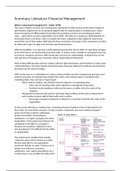Samenvatting
Samenvatting Literatuur Financial Management HCM
- Instelling
- Erasmus Universiteit Rotterdam (EUR)
Samenvatting van de verplichte literatuur van elke week voor het vak Financial Management (Koller, Porter, Oostenbrink & Rutten, Chan, Young, Kleinmuntz & Kleinmuntz, Zimmerman, Barnum, Kutzin & Saxenian, OECD)
[Meer zien]




